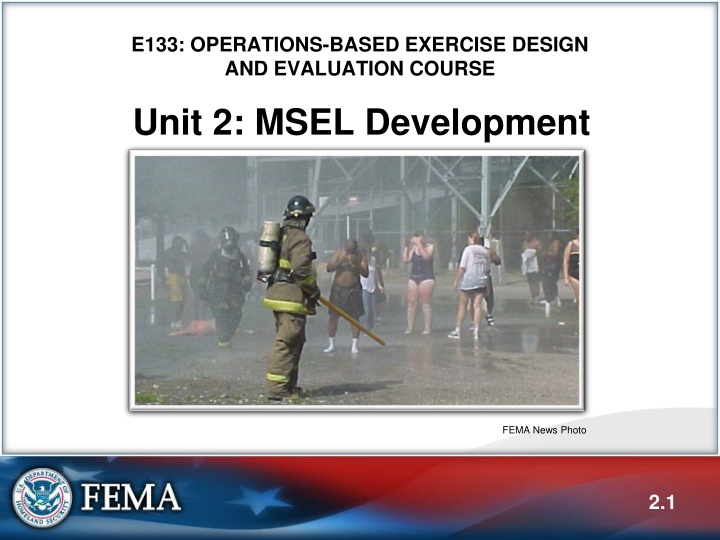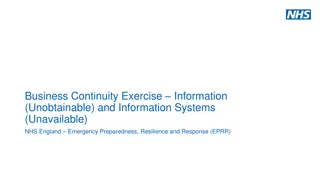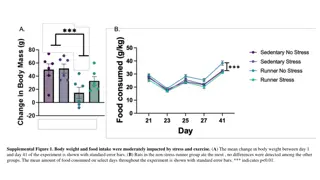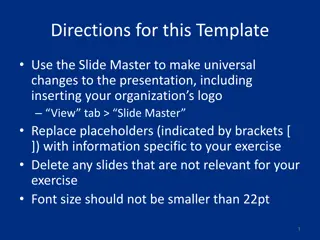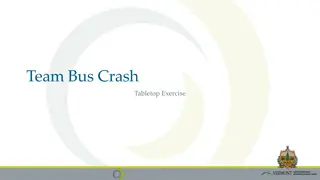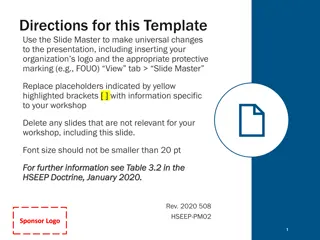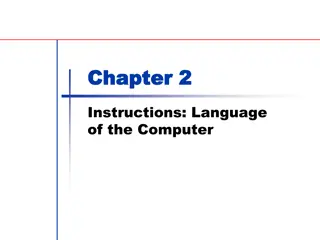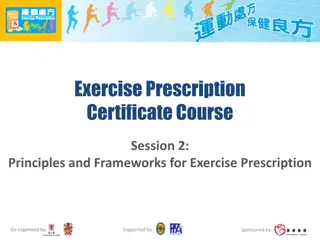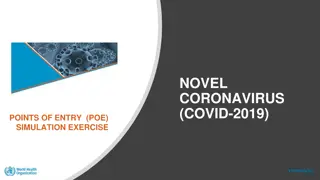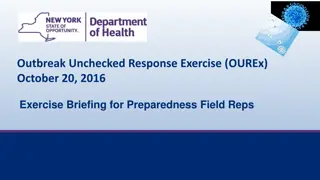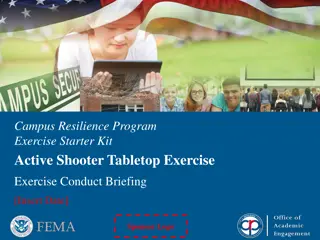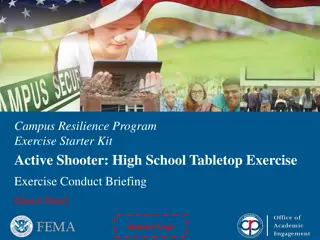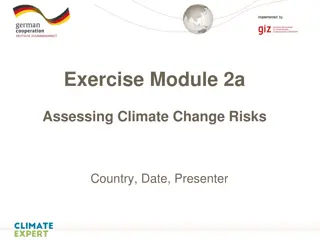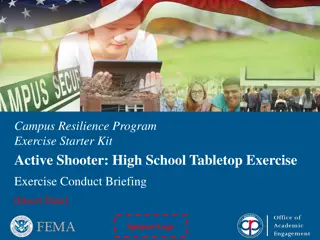Operations-Based Exercise Design Steps and Objectives Overview
This content provides a detailed overview of the steps involved in designing operations-based exercises, focusing on defining objectives using the SMART system. It emphasizes the importance of clear and concise objectives that are focused on player performance, with examples and guidelines for creating effective objectives. Understanding objectives is crucial for evaluating participant performance in exercises and ensuring that critical tasks are addressed. The content also touches on integrating multiple entities and demonstrating tactical-level issues in operations-based exercises.
Download Presentation

Please find below an Image/Link to download the presentation.
The content on the website is provided AS IS for your information and personal use only. It may not be sold, licensed, or shared on other websites without obtaining consent from the author.If you encounter any issues during the download, it is possible that the publisher has removed the file from their server.
You are allowed to download the files provided on this website for personal or commercial use, subject to the condition that they are used lawfully. All files are the property of their respective owners.
The content on the website is provided AS IS for your information and personal use only. It may not be sold, licensed, or shared on other websites without obtaining consent from the author.
E N D
Presentation Transcript
E133: OPERATIONS-BASED EXERCISE DESIGN AND EVALUATION COURSE Unit 2: MSEL Development FEMA News Photo 2.1
Unit Objectives By the end of this unit you will be able to: Explain the Eight Exercise Design Steps with regard to operations-based exercises Develop major and detailed events, expected actions, and injects for an operations-based exercise List the information contained in a MSEL Describe the documentation and tools used with operations-based exercises 2.2
Eight Exercise Design Steps 1. Assess needs 2. Define the scope 3. Write a statement of purpose 4. Define objectives 5. Compose a narrative 6. Write major and detailed events 7. List expected actions 8. Prepare injects E133 picks up with Step 4 2.3
Step 4: Define Objectives A description of the capabilities in which you expect the participants to possess competence Objectives must be clear, concise, and focused on player performance. They should contain: An action, stated in observable terms The conditions under which the action will be performed Identification of who should perform the action Standards of performance 2.4
Step 4: Define Objectives (contd.) Use the SMART system Specific Measurable Achievable Relevant Time-bound 2.5
Step 4: Define Objectives (contd.) Objectives for operations-based exercises typically focus on: Integration of multiple entities Systems-level and tactical-level issues that are physically demonstrated either in an EOC or in the field Sample objectives for operations-based exercises in Participant Guide (PG) 2.6
Objectives and Evaluation Writing objectives is the beginning of the exercise evaluation process: The process of identifying evaluation criteria happens when objectives are written Evaluators use objectives to evaluate performance The AAR/IP is based on the objectives To ensure objectives provide useful evaluation measures, include specific critical tasks in the EEGs Example of objective/tasks in an EEG in PG 2.7
Objectives and Evaluation (contd.) How would the objective and corresponding EEG look different if this was for a discussion-based exercise? Discussion 2.8
Objectives and Evaluation (contd.) Are the critical tasks in the EEG clearly tied back to the exercise objective? Discussion 2.9
Activity #1: FE Preparation: Objectives 2.10
Activity #1: FE Preparation: Objectives (cont d.) 1. Refer to Activity #1: FE Preparation Worksheet, in your PG 2. Complete the Objectives row Develop three objectives for your FE Use your group s disaster category, priority, and core capabilities from E132 Remember to first conduct a needs assessment and develop a scope and purpose. Use the information provided in the ESSD, Section 3.0, Hazard/Vulnerability Analysis (HVA) 2.11
Activity #1: FE Preparation: Objectives (cont d.) 3. Work in your Proficiency Demonstration groups 4. Submit your objectives to your group instructor for review and acceptance Your goal is to get your group instructor s approval to progress with your objectives and use them for your FE 5. You have 30 minutes to complete the activity Ensure your objectives are reviewed early enough to allow time to implement feedback and get acceptance 2.12
Step 5: Compose a Narrative A brief description of the events that have occurred up to the minute the exercise begins Provided in the Controller/Evaluator (C/E) Handbook and MSEL, and briefed to the exercise participants at StartEx Sample narrative in PG 2.13
Step 6: Write Major and Detailed Events Events are: Occurrences that happen as a result of the emergency described in the narrative Problems requiring actions that will meet the objectives The goal is to provide a structure that will: Link the simulated event to the expected player actions Provide unity to the exercise Careful scripting is required to: Produce a convincing, unified scenario Create an exercise governed by objectives 2.14
Developing Major Events To develop major events: 1. Identify major occurrences that might follow the narrative events 2. Select those that will likely generate situations to test the objectives In discussion-based exercises, a major event is usually introduced in a new module; in operations-based exercises, major events can be injects as part of the overall MSEL 2.15
Developing Major Events Example What are some major events that might follow from the airplane crash narrative? 1. Fuselage breaks apart and hits buildings below 2. Jet fuel ignites several homes in the area 3. About 60 survivors are thought to be trapped in the front section of the aircraft 4. Several bystanders are injured on the ground 5. A crowd convenes around the crash site 6. Family members of victims begin to gather at the crash site 7. Estimates of passenger casualties rise to 200 to 220 deaths and at least 70 severe burn victims 2.16
Use Your Purpose Statement Because your goal is to develop an exercise that will test certain functions and organizations, major events should be developed from your purpose statement. FEMA News Photo 2.17
Use Your Purpose Statement Example Airplane crash example: Major Event Core Capabilities Tested 1. Fuselage breaks apart and hits buildings below Operational Coordination On-Scene Security and Protection Public and Private Services and Resources 2. Jet fuel ignites several homes in the area 3. About 60 survivors are thought to be trapped in the front section of the aircraft Mass Search and Rescue Operations 2.18
Developing Detailed Events Detailed events: Specific problem situations that will prompt one or more expected actions To develop detailed events: List specific problems likely to occur in connection with each major event Identify actions that would be expected to address them Develop the detailed events in chronological order of expected occurrence 2.19
Detailed Events Example Airplane crash major event #7: Estimates of passenger casualties rise to 200 deaths and at least 70 severe burn victims Possible detailed events: Mortuary cannot accept so many remains Local hospitals lack specialized facilities and personnel to treat large numbers of severe burn victims The Red Cross has agreed to set up an information center to link victims and their families 2.20
Hazard Networks A useful tool for helping develop major and detailed events is FEMA s hazard networks They represent the potential cascading effects of a hazard in a visual, network-style format The hazard networks come from FEMA s discontinued Full-Spectrum Risk Knowledgebase Copies of the hazard networks are provided on the Shared Drive, and a copy of the hazard network for an airplane crash is provided in your Participant Guides 2.21
Activity #2: FE Preparation: Major and Detailed Events 2.23
Activity #2: FE Preparation: Major and Detailed Events (cont d.) 1. Refer back to Activity #1: FE Preparation Worksheet, in your PG 2. Complete the Major Events and the Detailed Events rows: Write one major event for each objective Write two detailed events for each major event 3. Work in your groups 2.24
Activity #2: FE Preparation: Major and Detailed Events (cont d.) 4. Submit your major and detailed events to your group instructor for review and acceptance 5. You have 30 minutes to complete the activity Ensure your major and detailed events are reviewed early enough to allow time to implement feedback and get acceptance 2.25
Step 7: List Expected Actions Expected actions: Actions or decisions you want participants to carry out in order to demonstrate competence Necessary for injects and evaluation Types of actions: Verification Consideration Deferral Decision 2.26
Step 7: List Expected Actions (contd.) How do you know what actions are appropriate in response to a given inject? Discussion 2.27
Relationship to Objectives Expected actions are closely tied to objectives Objectives state general desired actions Expected actions are a breakdown of objectives the actions that would be taken by an organization or an individual to meet the objective Example of the relationship between expected actions and objectives in PG 2.28
What to List Generally, every detailed event results in one or more expected actions List only those actions that involve the participating organizations List expected actions for all participating organizations It is not necessary for each detailed event to generate responses from all players 2.29
Step 8: Prepare Injects Injects are used to communicate detailed events to exercise participants Characteristics Purpose: Evoke a response (decision or action) to meet objectives Transmission: Phone, radio, note, fax, in person, etc. Credibility: Must come from credible source, through credible channels Sample injects provided in PG 2.30
Injects, Events, and Actions Injects and events One inject may represent one event, or several injects may be needed to notify participants of the event Injects and expected actions Each inject is designed to generate one or more expected actions Examples of injects that could achieve the expected actions in PG Sample inject planning sheet in PG 2.31
Inject Variables Who sends what to whom, how, with what effect? 2.32
Inject Format 2.33
Composing an Inject Injects should be developed by subject matter experts The starting point is the expected action Decide: What should the inject say? What would provide the desired expected action? Who will send it? How will the inject be transmitted? Who will receive it? Does it provide all of the necessary information? Keep it realistic! 2.34
Pulling It Together: The Master Scenario of Events List (MSEL) A chronological listing of scripted events and injects that generate activity in specific functional areas in support of exercise objectives Provides the framework for monitoring and managing the flow of exercise activities The primary document used by Controllers to manage the exercise Not utilized for discussion-based exercises Can be used for drills if the exercise planning team determines it to be appropriate 2.35
MSEL Development MSEL development process is simple use the Eight Exercise Design Steps There is no standard MSEL format Format depends on the scale and scope of the exercise Example of MSEL format in PG 2.36
MSEL Development (contd.) In the MSEL format example, notice the column for delivery time, and notice that it was left blank. What are your thoughts for including times in a MSEL? Discussion 2.37
MSEL Development (contd.) MSEL events: Contextual injects Expected action events (milestones) Contingency injects MSEL types Short: Inject, delivery time, short description, identifies responsible controller, and recipient player Long: Detailed description, exact quotes and formats for inject, and includes description of expected action. 2.38
MSEL Development (contd.) How do you develop your MSEL document in your jurisdiction? Discussion 2.39
MSEL Development (contd.) Review capabilities Identify chronology of key actions Anticipate Player actions Identify information resources Compile all MSEL events into single list Refine selected MSEL events; create detailed long version. 2.40
MSEL Development (contd.) Different ways to develop a MSEL: Chronological Threads Sticky Note Method taught in HSEEP (Timeline Development) 2.41
MSEL Best Practices Review scenario and exercise objectives Identify chronology of major/detailed events Develop a timeline of anticipated player actions Every agency/organization will not necessarily have a role in every major and detailed event Identify chronology of key actions Use an electronic MSEL program Compile all MSEL events into a single list Ensure no injects go to non-participants Refine selected MSEL events DO NOT show MSEL to participants! 2.43
MSEL Best Practices (contd.) Share your best practices for developing a MSEL: What works for you? Discussion 2.44
MSEL Injects MSEL injects are representative actions and scenario elements that drive exercise play They do three things: Link simulation to action Enhance exercise experiences for players Reflect an incident or activity that will prompt players to implement the policy or procedure being tested FEMA News Photo 2.45
Inject Information Each inject should specify: 1. Designated scenario time 2. Objective to be demonstrated 3. Controller responsible for delivering inject and input method 4. Intended player 5. Event description 6. Inject 7. Expected action (player response) 8. Notes Example provided in PG 2.46
Contingency Injects Players do not always respond as you expect It may become necessary for the controller and simulators to improvise injects Usually, the Senior Controller will decide on an appropriate response A contingency inject should not impact future injects or other expected participant actions it should move play forward in a manner that will permit Evaluators to determine if tasks were completed successfully A contingency inject should not be entered until approved by the Senior Controller 2.47
FE vs. FSE MSEL use during FE Monitors the progress of the exercise to keep it on schedule and on track Drives participant play MSEL use during FSE Supplements active play 2.48
Activity #3: FE Preparation: Expected Actions and Injects 2.49
Activity #3: FE Preparation: Expected Actions and Injects (cont d.) 1. Refer back to Activity #1: FE Preparation Worksheet in your PG 2. Complete the Expected Actions and Injects rows: Write one expected action for each detailed event Write one inject for each expected action 3. Work in your groups 2.50
